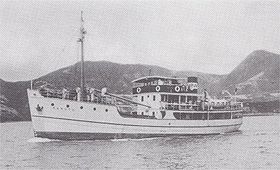
MV Mamutu
Encyclopedia

Burns Philp
Burns Philp was once a major player in the food manufacturing business. Since its delisting from the Australian Stock Exchange in December 2006 and the subsequent sale of its assets, the company has mainly become a cashed up shell company...
& Company, and at the outbreak of World War II, she was engaged in the evacuation of civilians ahead of advancing Japanese Forces.
With the onset of war, Mamutu served as a Stores Issuing Ship for ships of the Royal Australian Navy during 1941, returning to customary re-supply duty in January 1942. On 7 August 1942, she was sunk by enemy action in the Gulf of Papua near Murray Island, Torres Strait
Murray Island, Torres Strait
Murray Island is a small island of volcanic origin, populated by the Melanesian Meriam people and situated in the eastern section of Torres Strait, near the Great Barrier Reef. The island has a population of around 450.This island is one of the Torres Strait Islands and supports a population of...
, with the loss of 114 lives. Twenty-seven persons were thought to have survived by drifting to the coast on air-delivered rafts, while one person was taken back to Port Moresby by a Royal Australian Air Force rescue plane. The attack location, given by British Admiralty records, was 09.11S by 144.12E.
The following recounting of Mamutu's loss is drawn from the book "Battle Surface- Japan's Submarine War Against Australia 1942-1944" by David Jenkins. Published by Random House Australia 1992:-
reference
The submarine trailing Mamutu was a RO-33 class submarine
Kaichu type submarine
The submarines were double-hulled medium sized submarines of the Imperial Japanese Navy during World War II. They were derived from the .Several variants existed. From 1934 to 1944, the K6 type and the K7 type were built...
under the command of Lieutenant Commander Shigeshi Kuriyama. R.O.33 had a surface speed of 19 knots and was closing fast, as she drew near, Kuriyama ordered his crew to man the 3.25 inch gun mounted forward of the conning tower. At 300 metres, he gave the order to fire. The first shell ripped into the radio room, killing Furbank; the second shot carried away the bridge, killing Captain J. McEachern. Other shells tore into the hull. Within minutes, Mamutu was a scene of carnage with dead and dying littering the decks. Kuriyama then ordered his gunners to open fire with 13mm gunfire as survivors struggled in the water; men, women and children. He then retired, leaving Mamutu a sinking hull and most of her complement dead.
There were only 28 survivors from the total complement of 120 persons. One man, a European Engineer named Bill Griffin, escaped death at the hands of the ruthless machine gunners by pretending to be dead.
A B-17 Flying Fortress search aircraft dropped life rafts to the struggling survivors, who eventually made it to shore. The Army signal ship "MV Reliance," which was used by the Coast Watchers, was sent from Murray Island to try to pick up the survivors. They were unable to locate the survivors.
On 29 August 1942, RO-33 torpedoed the Burns Philp ship "Malaita
Malaita
Malaita is the largest island of the Malaita Province in the Solomon Islands. A tropical and mountainous island, Malaita's pristine river systems and tropical forests have not been exploited. Malaita is the most populous island of the Solomon Islands, with 140,000 people or more than a third of the...
" (3,310 tons) as she left Port Moresby. "Malaita" was being escorted by the destroyer HMAS Arunta (1870 tons). While "Malaita" was towed back to Port Moresby, Commander J.C. Morrow, the captain of HMAS Arunta made an asdic contact on RO-33. The Japanese submarine was sunk 10miles SE of Port Moresby (09-36S, 147-06E) with all hands lost as a result of a series of depth charge attacks by HMAS Arunta.

